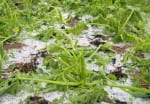
Everett Griner talks about weather damage caused by El Niño in today’s Agri View.
Weather Damage Costly
From Climate Central.org
What Is El Niño?
El Niño is a cyclical climate phenomenon that occurs every 3 to 5 years (though that return period can be as short as 2 and as long as 7 years). It’s defining characteristic is the buildup of warmer-than-normal surface waters over the eastern and central tropical Pacific Ocean. (This warm phase is part of a larger cycle called the El Niño-Southern Oscillation that also has a neutral phase and a cold phase, called La Niña.)
These warmer waters are linked to — or coupled with, as atmospheric scientists say — changes in the trade winds over the region. In neutral conditions, these winds blow from east to west across the basin, piling up the warm water in the western portion of the basin, near Indonesia. But during El Niño, the winds relax, and the warm water slides back east, like a ball rolling down a hill.
The warm water fuels thunderstorms in the atmosphere overhead, which in turn warms the atmosphere through a process called latent heating. The shift in where the warm water is and the increase in the heat the ocean releases cause a shift in this storminess and heating, which affects one of the main circulations of the atmosphere, the Hadley circulation. The Hadley circulation features air rising near the equator and traveling toward higher latitudes where it sinks and flows back to the equator. The increased heat from El Niño turbocharges the poleward flow, which in turn causes further changes in atmospheric flow, including to the jet stream over the Pacific.
“The phenomenon itself is specific to the tropical Pacific, even though it does have worldwide impacts,” Goddard said during the press call.
While the atmospheric conditions with the current anticipated event haven’t yet shaped up to the point that NCEP and IRI forecasters are willing to officially declare an El Niño, they still place an 80 percent chance on one happening by late fall.
“It’s fairly confident, but it’s not a slam dunk,” Anthony Barnston, IRI’s chief forecaster, told Climate Central.
Climate Central’s own meteorologist, Bernadette Woods Placky, explains what you need to know about El Niño in just 90 seconds.
Food and Agriculture Organization of the United Nation “Understanding the drought impact of El Niño on the global agricultural areas: An Assessment Using FAO’s Agriculture’s Stress Index (AEI)“









